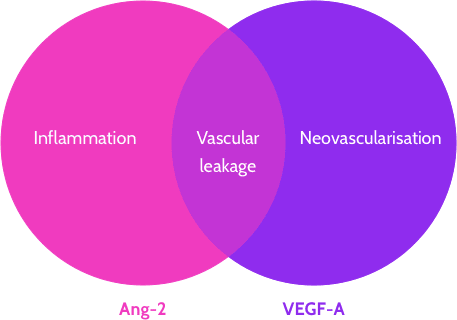The hidden predator
The VEGF pathway plays a pivotal role in driving retinal and choroidal vascular disease, but it does not work alone.1-4
Similar to the natural predators that hide in the world around us, VEGF has an accomplice that has been hiding in plain sight all along.

The threat that’s lurking in nAMD and DME
nAMD and DME are multifactorial diseases, driven by a number of pathways.2,3
This may explain why current IVT treatments that target the VEGF pathway alone require frequent injections to maintain vision gains:
Need anti-VEGF IVT as frequently as every 4-8 weeks, resulting in high patient and clinic burden.5-8

It’s time to spot the hidden predator
We now know that Ang-2 is a key driver of several retinal and choroidal vascular diseases, with elevated Ang-2 levels observed in the vitreous of eyes with nAMD, DR, DME and RVO.2
Ang-2 amplifies damage from VEGF-A and drives vascular instability which is characterised by:1-4

Travel inside the eye
Eye Travel Systems 2.0 is an interactive platform designed for Eye Travel simulation. Our cutting-edge platform will enable you to embark upon a series of Eye Travel experiences as you voyage through the retinal vessels. View our latest video to discover more on the drivers of retinal vascular diseases.
By registering your interest, you agree to receive communications from Roche Ophthalmology, including website updates.
We are collecting this information to personalise your experience and we commit to not share your data with third parties.
References
1. Heier JS et al. The angiopoietin/Tie pathway in retinal vascular diseases: A Review. Retina. 2021;41(1):1-19.
2. Regula JT, et al. Targeting key angiogenic pathways with a bispecific CrossMAb optimized for neovascular eye diseases [published correction appears in EMBO Mol Med. 2019 May;11(5):]. EMBO Mol Med. 2016;8(11):1265-88.
3. Saharinen P, Eklund L, Alitalo K. Therapeutic targeting of the angiopoietin-TIE pathway. Nat Rev Drug Discov. 2017;16(9):635-61.
4. Joussen AM, Ricci F, Paris LP, Korn C, Quezada-Ruiz C, Zarbin M. Angiopoietin/Tie2 signalling and its role in retinal and choroidal vascular diseases: a review of preclinical data. Eye (Lond). 2021;35(5):1305-16.
5. Ciulla TA et al. Visual Acuity Outcomes and Anti-Vascular Endothelial Growth Factor Therapy Intensity in Neovascular Age-Related Macular Degeneration Patients: A Real-World Analysis of 49 485 Eyes. Ophthalmol Retina 2020;4(1):19-30.
6. Skelly A et al. Treat and Extend Treatment Interval Patterns with Anti-VEGF Therapy in nAMD Patients. Vision (Basel). 2019;3:41.
7. DeCroos FC et al.Treat-and-Extend Therapy Using Aflibercept for Neovascular Age-related Macular Degeneration: A Prospective Clinical Trial. Am J Ophthalmol. 2017;180:142–50.
8. Ciulla TA et al.Visual acuity outcomes and anti-VEGF therapy intensity in diabetic macular oedema: a real-world analysis of 28 658 patient eyes. Br J Ophthalmol. 2021;105(2):216-21.




